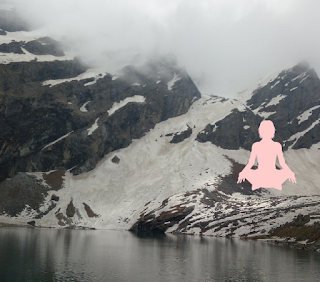Mula bandha, Jalandhar bandha and Uddiyan bandha | For Advanced pranayamas | More benifits
The three bandhas are
Mula bandha, uddiyan bandha and Jalandhar bandha; their purpose is to attain
stability and adapted to conserve and make use of the vast reserves of prana
energy which generated by the advanced breathing pranayamas and enable to
regulate pranic energy flow for advanced yoga technique. Mula bandha and
Jalandhar bandh are to perform concurrently during the retention to unite Prana
and Apana Vayu, around abdominal or navel area. Applying the uddiyan bandh is
only aimed to push up both pranas Vayu (Prana and Apana) into the Sushumna
Nadi.
Mula bandha: Sit in Padam asana or
Siddha asana and breathe easily and when you want to do advanced pranayamas.
Mula bandha practice during advanced pranayama exercises as pulling up the
Apana Vayu by contracting anal sphincter
muscles and then abdominal muscles.
Uddiyan bandha: After exhaling, pull
the stomach up and then back towards the spine and keep sitting in the Siddha
asana with both bandhas ( Mula bandha and Uddiyan bandh; in advanced practices
Jalandhar bandha also apply)
Jalandhar bandha: while retaining the
breath, bend the head forward so that the chin almost touches the pit and lift
the head when exhaling.
After one attaining
proficiency in asanas, bandhas and pranayamas can do mudra efficiently. This
three bandhas should be practised together for long hours, and if you want to
do Kumbhaka, then you have to hold your breath during this time. Kumbhaka is
required to do for a long time when one has practised it with bandhas and
mudras; accomplished by filling the air in the chest and light breathing goes
on.
Advanced breathing:
Once you have been exercising of Nadi Sudhi, Kapalbhati
and Anuloma-Viloma pranayamas for a couple of months with
at ease; you can better start of advanced breathing techniques of pranayama
that would comprise with the three bandhas of expanding pranayama session and
control prana energy flow into the seven chakras, sub-chakras and organs of the
body, and keeps more active five major Prana-vayu and sub-pranas Vayu. Advanced
pranayama exercises with three bandhas are not ordinary means to raise the
pranic energy flow. Pranayama is
the chief constituent of yoga, and is known as the technique of breath control;
it enhances the strength of pranas, nervous system and organs. Pranayama
prolongs life and provides more oxygen to the brain and heart that enables and
begets activeness, lightness, flexibility, stamina and strengthens in all
majors and minors organs of the body within a few days of practising it.
The chakras are the
psychic energy centre in the body:
Each of the chakras has
a distinct colour, shape element, deity and a monosyllabic. These chakras are
Ajna, Vishuddha, Anahata, Manipura, Svdhishthana and Muladhara. The chakras are
the focal points, pranic energy, and psychic forces-bodily forces merge with or
interact with each other.



Very nice Pranayamas
ReplyDeleteVery nice 👌👍
ReplyDelete